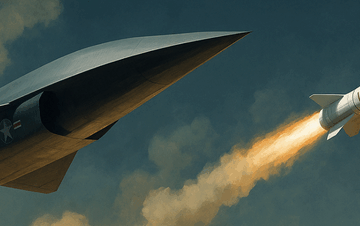The geographical position and long-standing ambitions for regional influence are long-time influences of Iran’s geostrategic thinking. As a state that controls a critical part of the Strait of Hormuz, a key global oil shipping passage, Iran’s focus is on securing dominance in the Gulf. However, Iran’s aspirations extend far beyond this region. The regime developed a broader strategy to assert power across the Middle East, utilizing a complex network of alliances and proxy forces to influence regional dynamics along with a specific focus on the eastern Mediterranean as well as the southern Red Sea.
The core of Iran’s strategy is its desire to build two major corridors of influence. The first stretches west to the Mediterranean via Iraq, Syria, and Lebanon, where Iran’s alliance with Hezbollah plays a central role. This “Shia Crescent” provides Tehran with a direct line of influence and military capability near Israel’s borders.
The second strategic corridor runs through Yemen to the southern Red Sea, where Iran’s support for the Houthi rebels positions it to disrupt maritime traffic and challenge Saudi Arabia’s influence in the region. Both corridors are critical to Iran’s broader objective of positioning itself as a dominant power in the region, capable of challenging Israel, the Kingdom of Saudi Arabia (KSA), and Western interests.
In the current conflict with Israel, both the West Bank, bordering Jordan, and Gaza, bordering Egypt, serve as crucial strategic pressure points for Israel. Iran views Gaza as a key element in its wider strategy to surround Israel with hostile forces. Although Iran does not directly control the armed Palestinian groups in Gaza, their shared objectives make them natural allies.
This presents Iran with the opportunity to capitalize on such a situation and continue to provide support to groups like Hamas, despite their current ineffectiveness and only increasing the likelihood of a wider-scale war in the region. For years, Egypt, with an emphasis on regional stability and peace, indirectly managed Gaza’s political agenda. However, in recent years, Hamas increasingly aligned itself with Iran, a country primarily focused on regional destabilization and triggering armed confrontations.
Iran’s increased backing for Hamas in Gaza in recent years reflects a comprehensive strategy aimed at surrounding Israel from multiple fronts. Hezbollah, supported by Iran, projects influence from both Lebanon and Syria. Iran’s engagement in Yemen strategically places it adjacent the Red Sea, positioning Iran as a potential threat to international maritime routes as well as to most of the nations in Yemen’s vicinity.
Gaza, situated along Israel’s southwestern border, forms a crucial point in this intricate web of tension. While Egypt exercises stringent oversight of its border with Gaza and consistently opposes Iranian influence, Tehran’s backing of Palestinian groups aligns with its overarching strategy to apply pressure on Israel from multiple fronts. However, the relationship between Egypt and Iran is strained—since the 1970s—particularly given the enduring peace treaty between Egypt and Israel.
The current conflict between Israel and Palestinian factions illustrates a significant shift in the behavior of non-state armed groups. In Syria, various rebel factions fought against the government, which is supported by Iran, but often harboured animosity toward one another, as their objectives and alliances are/were not unified. By contrast, in the context of the Israeli-Palestinian conflict, the non-state actors—Hamas, Islamic Jihad, and other factions—share a common enemy (Israel) and a broadly unified goal: weakening of Israeli military and political control.
This alignment of interests made Iran’s role in supporting these groups more influential and effective, even if Tehran does not have direct command over them. However, the regional threat posed by this situation stems from Iran’s lack of genuine concern for the Palestinian cause and its failure to support the Palestinians in achieving a peaceful resolution with Israel, including the two-state solution that most Western and Arab nations proposed over the past decades. This further supports the claim that Iran’s main objective is to disseminate its ideology and expand its regional power through persistent destabilization tactics.
While the current Palestinian factions in Gaza and the West Bank share common goals with Iran, they were neither previously nor currently formal proxies to it, unlike Hezbollah in Lebanon or the Houthis in Yemen. However, Iran’s ability to support and influence these groups through financial and military aid allows it to project power in the region indirectly. For Iran, Gaza serves as a crucial point in its strategy of regional influence, even though the Palestinian factions maintain their independence from direct Iranian control.
Egypt, on the other hand, is a strategically more complicated case for Iran given the fact that Cairo has always perceived any Iranian presence near its borders as a direct threat to its national security. This has led to a long-standing Egyptian policy of limiting Iranian influence in Gaza and rejecting any Iranian foothold in its immediate vicinity.
However, Iran has sought to circumvent this by expanding its influence in Libya and Sudan. By supporting and arming militias and armed groups present in Egypt’s neighbouring countries, Iran would ultimately aim to surround Egypt with allies or proxies, potentially allowing it to exert pressure on Cairo from multiple fronts. This strategy could eventually create openings for Iran to influence Egypt’s policies regarding Gaza and its relations with Israel.
Despite that Iran’s regional ambitions have always been clear to Egypt, the unprecedented level of war risk presented to the Middle East region further presents Egypt with increasing challenges concerning Iran’s regionally backed groups.
Iran’s possible sway in Libya and Sudan places Tehran in a strategic position to constrict Egypt from the west and south, resulting in a geopolitical pressure point. Nevertheless, the circumstances in Sudan demand greater attention. While Egypt and Iran back the Sudanese Armed Forces (SAF), Iran’s unrestrained backing of the SAF presents a potential risk to Egypt, as it may result in a rise in Iranian influence and connections within Sudan, ultimately advancing Tehran’s objectives.
The recent attacks by Yemen’s Houthis in the Red Sea have profoundly affected Egypt’s revenue from the Suez Canal over the past 10 months, presenting an ongoing danger to global shipping routes that traverse the Bab al-Mandeb Strait followed by the Red Sea then the Suez Canal. Consequently, Tehran has the potential to exert greater control or cause disturbances in maritime traffic through this vital passage, particularly during periods of increased tension, due to Iran’s expanding presence in Sudan, which is also situated close to the southern gateway of the Red Sea.
In parallel, Iran has pursued diplomatic engagement with Egypt, recognizing the potential benefits of normalized relations. Iran’s foreign minister recently visited Egypt to discuss Gaza-related regional tensions. Tehran apparently hopes to use soft power tools to build ties with Egypt.
A clear goal for Iran would be to create a network of influence with Egypt that complements its broader regional strategy in the Middle East. Should Iran succeed in building a stronger relationship with Egypt, it would be better positioned to influence events in Gaza, Libya, and Sudan, further consolidating its regional presence.
In contrast, Iran’s prospects of success in Jordan appears to be more limited. The Jordanian government’s strong ties with the United States and its historical enmity with Iran make Amman a more difficult target for Iranian influence. However, Iran may still view the sizable Palestinian population in Jordan as a potential pressure point.
By appealing to Palestinian nationalist sentiments and leveraging its support for Palestinian groups in Gaza and the West Bank, Iran could attempt to destabilize Jordan or at least pressure its government into altering its policies regarding Israel and the Palestinians. While this is a more challenging front for Iran, it remains a part of its broader geostrategic calculus.
Iran’s regional strategy capitalizes on building and supporting a complex web of alliances, proxy forces, non-state actors, and soft power tools, all aimed at expanding its influence and challenging its adversaries. Through direct military backing for entities such as Hezbollah and the Houthis, as well as indirect sway over Palestinian groups and diplomatic interactions with regional players like Egypt and the KSA, Iran persistently seeks to establish itself as a pivotal force in the geopolitics of the Middle East, while simultaneously exacerbating regional tensions and engaging in destabilizing activities.
Dr. Mohamed ElDoh is a business development and consulting professional in the defense and security sector.
About the Author
Mohamed El Doh
Mohamed El Doh is a business development and consulting professional in the defense and security sector. Mohamed holds a doctorate degree from Grenoble École de Management, France, an MBA from the European Union Business School, Spain, and an Advanced Certificate in Counterterrorism Studies from the University of St Andrews, UK.





Thank you Dr Mohamed El Doh for this compelling assessment. Your piece brings much needed strategic clarity with regard to an (literally) exploding environment where noise and fog of war can easily impair judgement, as the dust never seems to settle.